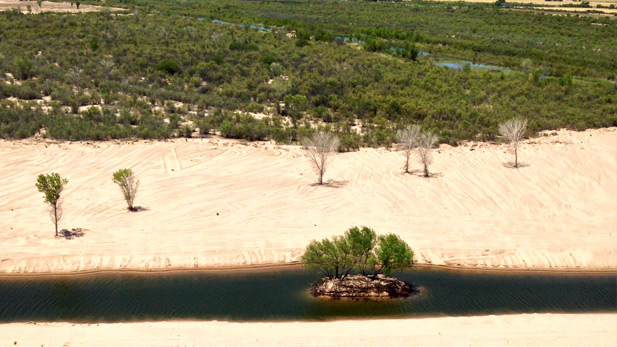 A "pulse flow," the first stage of a pilot project to bring life back to the Colorado River delta, flooded parts of the delta in Mexico’s Baja California state in 2014.
A "pulse flow," the first stage of a pilot project to bring life back to the Colorado River delta, flooded parts of the delta in Mexico’s Baja California state in 2014.By Maya Springhawk Robnett, Arizona Science Desk
The 2014 release of more than 32 billion gallons of water from a dam near Yuma into the Colorado River Delta in Mexico had an unexpected environmental side effect - the release of greenhouse gases, a scientist said.
In 2014, the United States and Mexico agreed to release more than 100,000 acre-feet of Colorado River water from the Morelos Dam to the Sea of Cortez in Mexico as was part of a historic agreement called the Minute 319 Pulse Flow.
It had been more than two decades since Colorado River water flowed into the Sea of Cortez. The intent of the release was to help restore a parched ecosystem damaged by drought and high demand.
Scientists watched closely as the water wound its way through the dry delta and noticed the water bubbling at the surface. They thought at first it was air, but recent tests revealed something more environmentally ominous. The river was releasing greenhouse gases like carbon dioxide and methane that had been trapped in the ground for decades.
“We think what’s going on there in the dry riverbed, there’s organic matter from the times when the river was still flowing and that’s being broken down by soil microbes," said Karl Flessa, a professor of geosciences at the University of Arizona and a co-chief scientist of the Minute 319 Monitoring Program.
Some parts of the river displayed 30 percent more carbon dioxide than normal levels. It’s a rare phenomenon that Flessa said needs more research.
“One of the things that happens when you put water in a dry riverbed, not surprisingly in the desert, things get green," he said. "So I would put a big bet on the fact that any carbon that might’ve been released as a consequence of the pulse flow was quickly taken up by the new vegetation.”


By submitting your comments, you hereby give AZPM the right to post your comments and potentially use them in any other form of media operated by this institution.